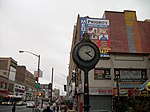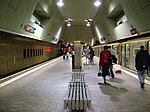Jamaica Savings Bank
1898 establishments in New York CityBank buildings in New York CityBank buildings on the National Register of Historic Places in New York CityBeaux-Arts architecture in New York CityCommercial buildings completed in 1898 ... and 4 more
Commercial buildings in Queens, New YorkJamaica, QueensNational Register of Historic Places in Queens, New YorkNew York City Designated Landmarks in Queens, New York

The Jamaica Savings Bank was a bank incorporated in 1866 in the Jamaica section of the borough of Queens in New York City. It had four branches across Queens before it was acquired by North Fork Bank in 1999, which itself was acquired by Capital One Bank in 2008. The bank's original building was built between 1897 and 1898 in the Beaux-Arts style. It is a slender four story brick building with a limestone facade. It features a deeply rusticated ground floor with windows protected by elegant metal grilles. The facade is framed by double-story pilasters and covered with elaborate carved brackets, swags and other elements.
Excerpt from the Wikipedia article Jamaica Savings Bank (License: CC BY-SA 3.0, Authors, Images).Jamaica Savings Bank
Jamaica Avenue, New York Queens
Geographical coordinates (GPS) Address External links Nearby Places Show on map
Geographical coordinates (GPS)
| Latitude | Longitude |
|---|---|
| N 40.70358 ° | E -73.79851 ° |
Address
Jamaica Avenue 161-02
11433 New York, Queens
New York, United States
Open on Google Maps








